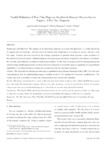Mostrar o rexistro simple do ítem
Parallel definition of tear film maps on distributed-memory clusters for the support of dry eye diagnosis
| dc.contributor.author | González-Domínguez, Jorge | |
| dc.contributor.author | Remeseiro, Beatriz | |
| dc.contributor.author | Martín, María J. | |
| dc.date.accessioned | 2018-08-14T08:42:14Z | |
| dc.date.available | 2018-08-14T08:42:14Z | |
| dc.date.issued | 2017 | |
| dc.identifier.citation | Jorge González-Domínguez, Beatriz Remeseiro, María J. Martín, Parallel definition of tear film maps on distributed-memory clusters for the support of dry eye diagnosis, Computer Methods and Programs in Biomedicine, Volume 139, 2017, Pages 51-60, ISSN 0169-2607, https://doi.org/10.1016/j.cmpb.2016.10.027. | es_ES |
| dc.identifier.issn | 1872-7565 | |
| dc.identifier.issn | 0169-2607 | |
| dc.identifier.uri | http://hdl.handle.net/2183/20964 | |
| dc.description.abstract | [Abstract] Background and objectives The analysis of the interference patterns on the tear film lipid layer is a useful clinical test to diagnose dry eye syndrome. This task can be automated with a high degree of accuracy by means of the use of tear film maps. However, the time required by the existing applications to generate them prevents a wider acceptance of this method by medical experts. Multithreading has been previously successfully employed by the authors to accelerate the tear film map definition on multicore single-node machines. In this work, we propose a hybrid message-passing and multithreading parallel approach that further accelerates the generation of tear film maps by exploiting the computational capabilities of distributed-memory systems such as multicore clusters and supercomputers. Methods The algorithm for drawing tear film maps is parallelized using Message Passing Interface (MPI) for inter-node communications and the multithreading support available in the C++11 standard for intra-node parallelization. The original algorithm is modified to reduce the communications and increase the scalability. Results The hybrid method has been tested on 32 nodes of an Intel cluster (with two 12-core Haswell 2680v3 processors per node) using 50 representative images. Results show that maximum runtime is reduced from almost two minutes using the previous only-multithreaded approach to less than ten seconds using the hybrid method. Conclusions The hybrid MPI/multithreaded implementation can be used by medical experts to obtain tear film maps in only a few seconds, which will significantly accelerate and facilitate the diagnosis of the dry eye syndrome. | es_ES |
| dc.description.sponsorship | Ministerio de Economía y Competitividad; TIN2013-42148-P | es_ES |
| dc.description.sponsorship | Portugal. Fundação para a Ciência e a Tecnologia; POCI-01-0145-FEDER-006961 | es_ES |
| dc.description.sponsorship | Portugal. Fundação para a Ciência e a Tecnologia; UID/EEA/50014/2013 | es_ES |
| dc.description.sponsorship | Portugal. Fundação para a Ciência e a Tecnologia; SFRH/BPD/111177/2015. | es_ES |
| dc.language.iso | eng | es_ES |
| dc.publisher | Elsevier Ireland Ltd. | es_ES |
| dc.relation.uri | https://doi.org/10.1016/j.cmpb.2016.10.027 | es_ES |
| dc.rights | Atribución-NoComercial-SinDerivadas 3.0 España | es_ES |
| dc.rights.uri | http://creativecommons.org/licenses/by-nc-nd/3.0/es/ | * |
| dc.subject | Dry eye syndrome | es_ES |
| dc.subject | Tear film map | es_ES |
| dc.subject | Parallel programming | es_ES |
| dc.subject | High performance computing | es_ES |
| dc.subject | Message passing | es_ES |
| dc.title | Parallel definition of tear film maps on distributed-memory clusters for the support of dry eye diagnosis | es_ES |
| dc.type | info:eu-repo/semantics/article | es_ES |
| dc.rights.access | info:eu-repo/semantics/openAccess | es_ES |
| UDC.journalTitle | Computer Methods and Programs in Biomedicine | es_ES |
| UDC.volume | 139 | es_ES |
| UDC.startPage | 51 | es_ES |
| UDC.endPage | 60 | es_ES |
| dc.identifier.doi | 10.1016/j.cmpb.2016.10.027. |
Ficheiros no ítem
Este ítem aparece na(s) seguinte(s) colección(s)
-
GI-GAC - Artigos [181]






